The Biology of Parasites 1st Edition – Ebook PDF Version pdf download

https://ebookmass.com/product/the-biology-of-parasites-1stedition-ebook-pdf-version/
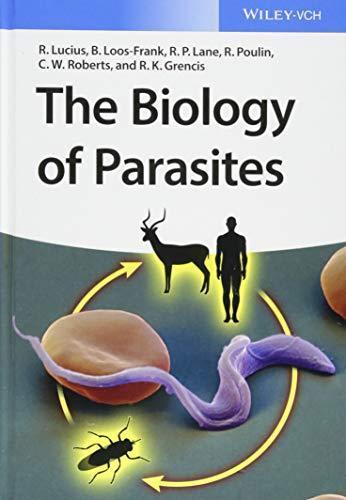
Explore and download more ebooks at ebookmass.com
We have selected some products that you may be interested in Click the link to download now or visit
Introduction to 80×86 Assembly Language and Computer Architecture – Ebook PDF Version
https://ebookmass.com/product/introduction-to-8086-assembly-languageand-computer-architecture-ebook-pdf-version/

Stern’s Introductory Plant Biology 13th Edition – Ebook PDF Version
https://ebookmass.com/product/sterns-introductory-plant-biology-13thedition-ebook-pdf-version/

Campbell Biology: Concepts & Connections 9th Edition –Ebook PDF Version
https://ebookmass.com/product/campbell-biology-conceptsconnections-9th-edition-ebook-pdf-version/
Discover Biology (Sixth Core Edition) Sixth Core Edition –Ebook PDF Version
https://ebookmass.com/product/discover-biology-sixth-core-editionsixth-core-edition-ebook-pdf-version/

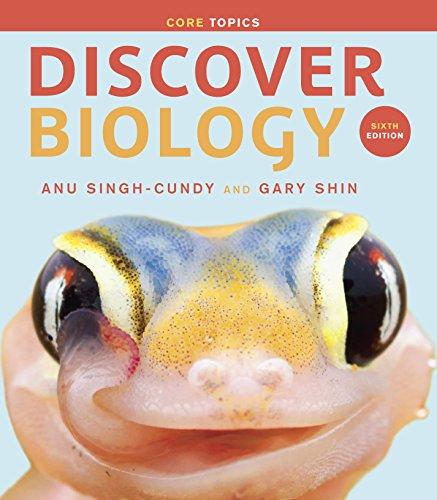
Molecular Biology of the Gene 7th Edition, (Ebook PDF)
https://ebookmass.com/product/molecular-biology-of-the-gene-7thedition-ebook-pdf/

The Law of Higher Education, 5th Edition – Ebook PDF
Version: Student Version Edition – Ebook PDF Version
https://ebookmass.com/product/the-law-of-higher-education-5th-editionebook-pdf-version-student-version-edition-ebook-pdf-version/
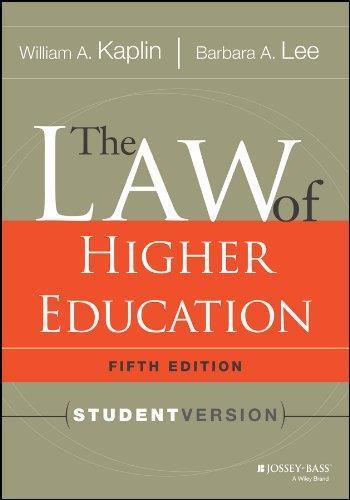
Care of the Well Newborn 1st Edition – Ebook PDF Version
https://ebookmass.com/product/care-of-the-well-newborn-1st-editionebook-pdf-version/

Essentials of Economics 1st Edition – Ebook PDF Version
https://ebookmass.com/product/essentials-of-economics-1st-editionebook-pdf-version/

Campbell Biology 11th Edition, (Ebook PDF)
https://ebookmass.com/product/campbell-biology-11th-edition-ebook-pdf/


VI Contents
1.6.1.3ScenariosofDefenseReactionsAgainstParasites 63
1.6.1.4Immunopathology 67
1.6.2ImmuneEvasion 68
1.6.3ParasitesasOpportunisticPathogens 72
1.6.4HygieneHypothesis:DoParasitesHaveaGoodSide? 74 FurtherReading 76
1.7HowParasitesAlterTheirHosts 77
1.7.1AlterationsofHostCells 78
1.7.2IntrusionintotheHormonalSystemoftheHost 79
1.7.3ChangingtheBehaviorofHosts 82
1.7.3.1IncreaseintheTransmissionofParasitesbyBloodsucking Vectors 83
1.7.3.2IncreaseinTransmissionThroughtheFoodChain 83
1.7.3.3IntroductionintotheFoodChain 88
1.7.3.4ChangesinHabitatPreference 92 FurtherReading 93
2BiologyofParasiticProtozoa 95
RichardLuciusandCraigW.Roberts
2.1Introduction 97 FurtherReading 98
2.2Metamonada 99
2.2.1 Giardialamblia99 FurtherReading 102
2.3Parabasala 102
2.3.1 Trichomonasvaginalis103
2.3.2 Tritrichomonasfoetus106 FurtherReading 106
2.4Amoebozoa 107
2.4.1 Entamoebahistolytica108
2.4.2 Entamoebadispar114
2.4.3Other Entamoeba Species 114
2.4.4FurtherIntestinalAmoebae 115
2.4.5 Acanthamoeba115 FurtherReading 116
2.5Euglenozoa 117
2.5.1CellBiologyandGenome 118
2.5.2Phylogeny 121
2.5.3 Trypanosomabrucei121
2.5.4 Trypanosomacongolense131
2.5.5 Trypanosomavivax132
2.5.6 Trypanosomaevansi133
2.5.7 Trypanosomaequiperdum133
2.5.8 Trypanosomacruzi134
2.5.9 Leishmania141
2.5.9.1Development 142
2.5.9.2Morphology 143
2.5.9.3Leishmaniosis 143
2.5.9.4CellandImmuneBiology 143
2.5.10 Leishmaniatropica148
2.5.11 Leishmaniadonovani150
2.5.12 Leishmaniabraziliensis and Leishmaniamexicana151 FurtherReading 151
2.6Alveolata 153
2.6.1Apicomplexa 155
2.6.1.1Development 155
2.6.1.2Morphology 157
2.6.1.3CellBiology 160
2.6.2Coccidea 165
2.6.2.1 Cryptosporidiumparvum166
2.6.2.2 Eimeria169
2.6.2.3 Eimeriatenella174
2.6.2.4 Eimeriabovis175
2.6.2.5 Isospora and Cyclospora175
2.6.2.6 Toxoplasmagondii176
2.6.2.7 Neosporacaninum186
2.6.2.8 Sarcocystis187
2.6.3Haematozoea 190
2.6.3.1 Plasmodium190
2.6.3.2 Plasmodiumvivax,aCausativeAgentofTertianMalaria 199
2.6.3.3 Plasmodiumovale,aCausativeAgentofTertianMalaria 200
2.6.3.4 Plasmodiummalariae,theCausativeAgentofQuartan Malaria 200
2.6.3.5 Plasmodiumfalciparum,theCausativeAgentofMalignantTertian MalariaorMalariatropica 201
2.6.3.6 Plasmodium speciesofMonkeys,Rodents,andBirds 210
2.6.4Piroplasms 211
2.6.4.1 Babesia211
2.6.4.2 Theileria214
2.6.5Ciliophora 218
2.6.5.1 Balantidiumcoli219
2.6.5.2 Ichthyophthiriusmultifiliis219
2.6.5.3 Trichodina221
FurtherReading 222
3ParasiticWorms 225 BrigitteLoos-FrankandRichardK.Grencis
3.1Platyhelminths 228
3.1.1Digenea 230
3.1.1.1Development 230
3.1.1.2Morphology 232
3.1.1.3Adults 234
3.1.1.4SystematicsandEvolutionaryHistory 237
3.1.1.5 Schistosoma238
3.1.1.6 Leucochloridiumparadoxum248
3.1.1.7 Diplostomumspathaceum248
3.1.1.8 Fasciolahepatica251
3.1.1.9 Opisthorchisfelineus254
3.1.1.10 Paragonimuswestermani257
3.1.1.11 Dicrocoeliumdendriticum259 FurtherReading 262
3.1.2Cestoda 263
3.1.2.1Development 265
3.1.2.2EvolutionandOriginofLifeCycles 266
3.1.2.3Morphology 266
3.1.2.4Genome 269
3.1.2.5Diphyllobothriidea 269
3.1.2.6 Mesocestoides272
3.1.2.7Cyclophyllidea 272
3.1.2.8 Monieziaexpansa273
3.1.2.9 Hymenolepisdiminuta274
3.1.2.10 Rodentolepisnana (Hymenolepisnana) 275
3.1.2.11Taeniidae 277
3.1.2.12 Taeniasaginata281
3.1.2.13 Taeniasolium282
3.1.2.14 Taeniaasiatica282
3.1.2.15 Hydatigerataeniaeformis283
3.1.2.16 Echinococcus283
3.1.2.17 Echinococcusgranulosus283
3.1.2.18 Echinococcusmultilocularis285
3.1.2.19 Echinococcusvogeli and Echinococcusoligarthrus286 FurtherReading 287
3.2Acanthocephala 288 FurtherReading 293
3.3Nematoda 294
3.3.1Development 295
3.3.2Morphology 297
3.3.3Dorylaimea 300
3.3.3.1 Trichinellaspiralis300
3.3.3.2 Trichuristrichiura305
3.3.4Chromadorea 306
3.3.4.1 Strongyloidesstercoralis306
3.3.4.2 Ancylostomaduodenale and Necatoramericanus308
3.3.4.3 Angiostrongyluscantonensis311
3.3.4.4 Haemonchuscontortus312
3.3.4.5 Dictyocaulusviviparus315
3.3.4.6 Ascarislumbricoides315
3.3.4.7 Ascarissuum318
3.3.4.8 Toxocaracanis318
3.3.4.9 Anisakissimplex and Anisakis spp. 320
3.3.4.10 Dracunculusmedinensis321
3.3.4.11 Enterobiusvermicularis323
3.3.4.12Filariae 325
3.3.4.13 Wuchereriabancrofti and Brugiamalayi326
3.3.4.14 Onchocercavolvulus330
3.3.4.15 Loaloa and Dirofilariaimmitis334
3.3.4.16RodentModelsofFilariosis 334 FurtherReading 335
4Arthropods 337
BrigitteLoos-FrankandRichardP.Lane
4.1Introduction 338
4.1.1VectorConcepts 340
4.1.2ImpactofBloodfeeding 343 FurtherReading 343
4.2Acari–MitesandTicks 344
4.2.1Morphology 346
4.2.2Development 347
4.2.3Anactinotrichida(= Parasitiformes) 347
4.2.3.1Mesostigmata 347
4.2.3.2 Dermanyssusgallinae348
4.2.3.3 Varroadestructor348
4.2.3.4Metastigmata(= IxodidaorIxodoidea,Ticks) 350
4.2.3.5Development 353
4.2.3.6TickBitesandSaliva 353
4.2.3.7Ixodidae–HardTicks 354
4.2.3.8Argasidae(SoftTicks) 358
4.2.3.9Tick-BorneDiseases 359
4.2.4Actinotrichida(= Acariformes) 361
4.2.4.1Prostigmata = Actinedida = Trombidiformes 362
4.2.4.2Trombiculidae–HarvestMites,Chiggers 363
4.2.4.3Astigmata = Acaridida = Sarcoptiformes 364 FurtherReading 365
4.3Crustacea 366
4.3.1 Argulusfoliaceus367
4.3.2 Sacculinacarcini368 FurtherReading 370
4.4Insecta 370
4.4.1Phthiraptera–Lice 374
4.4.2“Mallophaga”–ChewingLice 375
X Contents
4.4.3Anoplura–SuckingLice 375
4.4.3.1 Pediculushumanuscapitis377
4.4.3.2 Pediculushumanushumanus378
4.4.3.3 Pthiruspubis378
4.4.3.4DiseaseTransmissionbyLice 379
4.4.4Heteroptera–TrueBugs 380
4.4.5Triatominae–KissingBugs 380
4.4.6Cimicidae–Bedbugs 382
4.4.6.1 Cimexlectularius383
4.4.7Siphonaptera–Fleas 384
4.4.7.1BiologyandDevelopment 384
4.4.7.2Morphology 385
4.4.7.3 Pulexirritans387
4.4.7.4 Ctenocephalides:CatandDogFleas 387
4.4.7.5 Tungapenetrans –Jiggers 388
4.4.7.6DiseaseTransmissionbyFleas 388
4.4.8Diptera–Flies 390
4.4.8.1LowerDiptera 390
4.4.8.2Ceratopogonidae–BitingMidges,No-see-ums,Punkies 391
4.4.8.3DiseaseTransmission 393
4.4.8.4Culicidae–Mosquitoes 394
4.4.8.5DiseaseTransmission 398
4.4.8.6Simuliidae–Blackflies 401
4.4.8.7Phlebotominae–Sandflies 404
4.4.8.8Brachycera 408
4.4.8.9Tabanidae–HorseFlies 408
4.4.8.10Muscidae–HouseandStableFlies 410
4.4.8.11Calliphoridae–Blowflies,Screwworms 413
4.4.8.12Oestridae–BotorWarbleFlies 413
4.4.8.13Glossinidae–TsetseFlies 415
4.4.8.14Hippoboscidae,Nycteribiidae,Streblidae–LouseFlies,Kedsand BatFlies 418 FurtherReading 419
AnswerstoTestQuestions 423
Chapter1 423
Chapter2 426
Chapter3 429
Chapter4 431
Index 435
Preface
Parasitismisaspecializedwayoflife,pursuedbyorganismsthathaveevolvedto thriveattheexpenseofalivinghost.Therefore,inabroadsense,allpathogenslike viruses,bacteria,oreukaryoticinfectiousagentsareparasitesandthussharemany commonfeatures.However,theyalsohaveimportantdifferences.Forexample, virusesandbacteriaaregeneticallylesscomplexandemploydifferentstrategies forexploitingahost,leadingtodifferentdiseasesyndromes.Asaconsequence, differentscientificfieldshaveemerged,ofwhichthedisciplineofparasitologyis onethatdealswitheukaryoticpathogens,namely,protozoa,worms,andarthropods.Parasites,inthisnarrowersense,areahugeburdentomankind,withbillions ofinfectedpeople,mainlyintropicaldevelopingcountrieswithrelativelypoor hygiene.Alongwiththeirmedicalandveterinaryimportance,parasiteshavea fascinatingbiology,whichisthethemeofthisbook. TheBiologyofParasites is basedonanearlierGermanbook(Lucius&Loos-Frank(2008),SpringerVerlag, Heidelberg),whichhasbeenextendedandupdatedbythecurrentteamofauthors.
Thelivinghostisaveryparticularniche;itisnotaneutralplaceatall.Parasites areinvolvedinaconstantstrugglewiththeirhosts,whostrivetoridthemselves oftheunwantedcompany,deployingallsortsofmechanismsagainstthem.These rangefromdefensivebehaviortotheeffectormoleculesandcellsofacomplex immunesystem.Inspiteofsuchdefenses,anextraordinarynumberofanimals haveadoptedparasitismasamodeoflife;somespecialistsbelievethat >50%of animalspeciesareparasitesorhaveatleastaparasiticphaseintheirlifecycle. Itseemsthattheparasiticlifestyleissorewardingthatithasbeenworththe greateffortparasiteshavemadetodevelopmostintriguingmeansoflocating theirhosts,survivewithinoronthem,produceoffspring,andensurethatthenext generationreachesanewhost.Toexploitahost,parasitesmaychangetheirmorphologybeyondallrecognition:theymaytrickandcheatbydisguisingthemselves ormanipulatetheirhost’scellularpathwaysoreventheirbehavior.Becauseof theseextraordinary,bizarre,orseemingly“otherworldly”abilities,parasiteshave alwaysfascinatedbiologistsandcapturedtheattentionofthegeneralpublic.
Theantagonisticrelationshipbetweenpathogensandtheirhostsdrivestheevolutionofbothadversariesinaprofoundmanner.Thisarmsracehasaffectedthe evolutionofsomeofthemostimportantprocessesoflife,forexample,sexual reproductionandtheimmunesystem.Italsoshapedthegenomesofbothparties
toadegreethatwehaveonlyrecentlydiscovered.Indeed,newmoleculartechniquesdevelopedinpastfewdecadeshaveopenedanextraordinaryrangeofperspectivesontheinterplaybetweeneukaryoticparasitesandtheirhosts.Genome projectshavecastlightonthepeculiaritiesofparasitegenomes.Forexample, wehavelearnedthatmanyprotozoansandwormshaveundergoneareductive evolutionintheirgenomes,especiallywithregardtothosefunctionstheyhave appropriatedfromtheirhost,whileotherareashavebeenexpanded,suchasthose neededforthemanipulationofthehost.Thisexplosioningenomicknowledgehas alsoprovideduswiththetoolstodiscoveranddescribepreciselyparasite-specific metabolicpathways.Ithasalsofacilitatedthedissectionofmolecularmechanisms usedbyparasitestodetecthostcues,invadehostcells,orcopewithimmuneeffectormechanisms.Thisinformationhasalreadyallowedandwillhopefullyfurther allowustodesignspecificmeasuresagainstparasitesandtheirvectors,ranging fromstrategiestopreventinfection,suchasvaccinesandpesticides,todrugdevelopment.However,itisnotthesolegoalofparasitologiststofightdiseases,as worthyasthatis,buttounderstandtheintricaciesoftheparasiticlifestyleandto putthemintoabroaderbiologicalcontext.Thisgreatlycontributestoourwider understandingofkeybiologicalprocesses,suchasevolution,ecology,andgenerationofbiodiversity.Lastbutnotleast,thesimplewonderandawetheextraordinarybiologyofparasitesinstillsinusmakestheirstudyworthwhileinitsown right.
Thisbookisdesignedtoprovideadvancedinformationtostudentsofbiology, medicine,orveterinarymedicineandtointerestedlaypersons.Anintroductory chapterongeneralparasitology,addressingcrosscuttingtopicsofparasitology, isfollowedbyspecificchaptersonthebiologyofprotozoanparasites,parasitic worms,andparasiticarthropods.Thefocusisonparasitesofmedicalorveterinaryimportance,asthesearebestknownfromintensiveresearchandareofthe widestinterest,althoughwealsohighlightparasiteswithinterestingbiological adaptationstoemphasizethosetraitsmosttypicaloftheparasiticlifestyle.To beconcise,wediscussparticularspeciesasrepresentativesoftheirtaxon,while relatedparasitesarebrieflymentionedortreatedintabularform.Inevitably, thebookcannotcovertheentirefieldofparasitology.Itdoesnotgivedetailed treatmentofthetherapyorcontrolofparasiticinfections,parasiteecology, orevolutionaryparasitology.Likewise,wehavesparinglymentionedmarine parasitesorparasitoidsandtheirinterestingbiologies.Tocovercutting-edge topics,wehaveinvitedthreerenownedguestauthorstocontributeconcise informationfromtheirfieldofresearch,namely,JohnBoothroyd(parasite–host interplayof Toxoplasma),KaiMatuschewski(vaccinedevelopmentagainstthe malariaparasite Plasmodium),andNinaPapavasiliou(newdevelopmentsin trypanosomeresearch).
Wearethankfultomanycolleaguesfromdifferentfieldsofparasitologyand beyondfortheirhelpfuldiscussions.Wethankspecificallythosewhoprovided imagesofparasitesorillustrativeresearchdata,inparticularOliverMeckesand NicoleOttawafrom eyeofscience forfascinatingelectronmicroscopepictures, Prof.EgbertTannichforimagesofamoebae,andDr.HeikoBellmannforphotos
Preface XIII ofarthropods.WegratefullyacknowledgethepermissionoftheDepartmentsof ParasitologyofUniversityofHohenheimandofHumboldtUniversitytoutlize picturesfromtheirarchives.Thelifecyclesandotherdrawingsarebasedonthe painstakingworkofFlaviaWolf,Dr.J.Gelnar,andHannaZeckau,whichisgratefullyacknowledged.Aheartfeltthank-yougoestoChristineNowotnyforhermost professionalhelpwiththeorganizationofthemanuscriptandillustrations.This workwouldnothavebeenpossiblewithoutthecontinuoussupportofDr.Gregor CicchettiandDr.AndreasSendtkoandtheirteamfromthepublisherWiley-VCH, whichisgratefullyacknowledged.
September2016
RichardLucius
Berlin
Visit https://ebookmass.com today to explore a vast collection of ebooks across various genres, available in popular formats like PDF, EPUB, and MOBI, fully compatible with all devices. Enjoy a seamless reading experience and effortlessly download highquality materials in just a few simple steps. Plus, don’t miss out on exciting offers that let you access a wealth of knowledge at the best prices!
GeneralAspectsofParasiteBiology
RichardLuciusandRobertPoulin
1.1IntroductiontoParasitologyandItsTerminology2
1.1.1Parasites2
1.1.2TypesofInteractionsBetweenDifferentSpecies5
1.1.2.1MutualisticRelationships5
1.1.2.2AntagonisticRelationships6
1.1.3DifferentFormsofParasitism10
1.1.4ParasitesandHosts11
1.1.5ModesofTransmission16 FurtherReading17
1.2WhatIsUniqueAboutParasites?18
1.2.1AVeryPeculiarHabitat:TheHost18
1.2.2SpecificMorphologicalandPhysiologicalAdaptations22
1.2.3FlexibleStrategiesofReproduction27 FurtherReading29
1.3TheImpactofParasitesonHostIndividualsandHostPopulations30 FurtherReading37
1.4Parasite–HostCoevolution38
1.4.1MainFeaturesofCoevolution38
1.4.2RoleofAllelesinCoevolution42
1.4.3RarenessIsanAdvantage45
1.4.4MalariaasanExampleofCoevolution46 FurtherReading50
1.5InfluenceofParasitesonMateChoice51 FurtherReading57
1.6ImmunobiologyofParasites58
1.6.1DefenseMechanismsofHosts60
1.6.1.1InnateImmuneResponses(InnateImmunity)60
1.6.1.2AcquiredImmuneResponses(AdaptiveImmunity)62
TheBiologyofParasites, FirstEdition.RichardLucius,BrigitteLoos-Frank,RichardP.Lane,RobertPoulin, CraigW.Roberts,andRichardK.Grencis.
©2017Wiley-VCHVerlagGmbH&Co.KGaA.Published2017byWiley-VCHVerlagGmbH&Co.KGaA.
2
1GeneralAspectsofParasiteBiology
1.6.1.3ScenariosofDefenseReactionsAgainstParasites63
1.6.1.4Immunopathology67
1.6.2ImmuneEvasion68
1.6.3ParasitesasOpportunisticPathogens72
1.6.4HygieneHypothesis:DoParasitesHaveaGoodSide?74 FurtherReading76
1.7HowParasitesAlterTheirHosts77
1.7.1AlterationsofHostCells78
1.7.2IntrusionintotheHormonalSystemoftheHost79
1.7.3ChangingtheBehaviorofHosts82
1.7.3.1IncreaseintheTransmissionofParasitesby BloodsuckingVectors83
1.7.3.2IncreaseinTransmissionThroughtheFoodChain83
1.7.3.3IntroductionintotheFoodChain88
1.7.3.4ChangesinHabitatPreference92 FurtherReading93
1.1 IntroductiontoParasitologyandItsTerminology
1.1.1 Parasites
Parasitesareorganismswhichliveinoronanotherorganism,drawingsustenancefromthehostandcausingitharm. Theseincludeanimals,plants,fungi, bacteria,andviruses,whichliveashost-dependentguests.Parasitismisoneof themostsuccessfulandwidespreadwaysoflife.Someauthorsestimatethatmore than50%ofalleukaryoticorganismsareparasitic,orhaveatleastoneparasitic phaseduringtheirlifecycle.Thereisnocompletebiodiversityinventorytoverify thisassumption;itdoesstandtoreason,however,giventhefactthatparasiteslive inoronalmosteverymulticellularanimal,andmanyhostspeciesareinfectedwith severalparasitespeciesspecificallyadaptedtothem.Someofthemostimportant humanparasitesarelistedinTable1.1.
ThetermparasiteoriginatedinAncientGreece.ItisderivedfromtheGreek word“parasitos”(Greek pará = on,at,beside; sítos = food).Thenameparasitewas firstusedtodescribetheofficialswhoparticipatedinsacrificialmealsonbehalf ofthegeneralpublicandwinedanddinedatpublicexpense.Itwaslaterapplied tominionswhoingratiatedthemselveswiththerich,payingthemcompliments andpracticingbuffoonerytogainentrytobanquetswheretheywouldsnatch somefood.
1.1IntroductiontoParasitologyandItsTerminology 3
Table1.1 Occurrenceanddistributionofthemorecommonhumanparasites.
ParasiteInfectedpeople(inmillions)Distribution
Giardialamblia >200Worldwide Trichomonasvaginalis 173Worldwide Entamoebahistolytica 500*Worldwideinwarmclimates
Trypanosomabrucei 0.01Sub-SaharanAfrica(“Tsetse Belt”)
Trypanosomacruzi 7CentralandSouthAmerica
Leishmania spp.2Near + MiddleEast,Asia,Africa, CentralandSouthAmerica
Toxoplasmagondii 1500Worldwide Plasmodium spp. >200Africa,Asia,CentralandSouth America
Paragonimus sp.20Africa,Asia,SouthAmerica
Schistosoma sp. >200Asia,Africa,SouthAmerica
Hymenolepisnana 75worldwide
Taeniasaginata 77Worldwide
Trichuristrichiura 902Worldwideinwarmclimates
Strongyloidesstercoralis 70Worldwide
Enterobiusvermicularis 200Worldwide Ascarislumbricoides 1273Worldwide Ancylostomaduodenale and Necatoramericanus 900Worldwideinwarmclimates Onchocercavolvulus 17Sub-SaharanAfrica,Centraland SouthAmerica
Wuchereriabancrofti 107Worldwideinthetropics
Source: Compiledfromvariousauthors.
*manyofthoseasymptomticorinfectedwiththemorphologicallyidentical Entamoebadispar .
Theresultwasacharacterfigure,atypeofHarlequin,whohadafixedroleto playintheGreekcomedyofclassicalantiquity(Figure1.1).Later,“parasitus”also becameanintegralpartofsociallifeinRomanantiquity.Italsoreappearedin EuropeantheaterinpiecessuchasFriedrichSchiller’s“DerParasit.”Intheseventeenthcentury,botanistswerealreadydescribingparasiticplantssuchasmistletoe asparasites;inhis1735standardwork“Systemanaturae,”Linnaeusfirstusedthe term“specieparasitica”fortapewormsinitsmodernbiologicalsense.
Thedelimitationoftheterm“parasite”toorganismswhichprofitfroma heterospecific hostisveryimportantforthedefinitionitself.Interactionsbetween individualsofthesamespeciesarethusexcluded,evenifthebenefitsofsuchinteractionsareveryoftenunequallydistributedinthecoloniesofsocialinsectsand nakedmolerats,forinstance,orinhumansocieties.Asaresult,theinteraction betweenparentsandtheiroffspringdoesnotfallunderthiscategory,althoughthe directorindirectmannerinwhichtheoffspringfeedfromtheirparentorganism canattimesbereminiscentofparasitism.

Figure1.1 Parasitosmask,aminiatureofatheatermaskofGreekcomedy;terracotta, around100B.C.(FromMyrine(AsiaMinor);antiquitiescollectionoftheBerlinStateMuseums.Image:CourtesyofThomasSchmid-Dankward.)
Theprincipleofoneside(theparasite)takingadvantageoftheother(thehost) appliestoviruses,allpathogenicmicroorganisms,andmulticellularparasites alike.Thisiswhyweoftenfindthatnocleardistinctionismadebetween prokaryoticandeukaryoticparasites.Withregardto parasites, weusuallydonot differentiatebetweenviruses,bacteria,andfungiontheonehandandanimal parasitesontheother;wetendtoseeonlythecommonparasiticlifestyle.Even moleculestowhichafunctionintheorganismcannotbeassignedaresometimes describedasparasitic,suchasprions,forexample,thecausativeagentofspongiformencephalopathy,orapparentlyfunctionless“selfish”DNAplasmidsthatare presentinthegenomeofmanyplants.Manybiologistsareoftheopinionthat onlyparasiticprotozoa,parasiticworms(helminths),andparasiticarthropodsare parasitesinthestrictsenseoftheterm.Parasitology,asafield,isconcernedonly withthosegroups,whileviruses,bacteria,fungi,andparasiticplantsaredealt withbyotherdisciplines.Thisrestrictionclearlyhamperscooperationwithother disciplines,somethingthatseemsantiquatedintoday’smodernbiology,where alloflife’sprocessesaretracedbacktoDNA;itisgratifyingthattheboundaries haverelaxedinrecentyears.However,eukaryoticparasitesaredistinguished fromvirusesandbacteriabytheircomparativelyhighercomplexity,which impliesslowerreproductionandlessgeneticflexibility.Thesetraitstypicallydrive eukaryoticparasitestoestablishlong-standingconnectionswiththeirhosts, usingstrategiesdifferentfromthe“hit-and-run”strategiesusedbymanyviruses andbacteria.Forthesereasons,andforthesakeofclarityandtradition,only parasitesinthestrictersenseoftheterm,thatis,parasiticprotozoa,helminths, andparasiticarthropodsaredealtwithinthisbook.
1.1.2
TypesofInteractionsBetweenDifferentSpecies
Thecoexistenceofdifferentspeciesoforganismsinvolvesinteractionsamong themthattakemanydifferentformsinwhichthebenefitsandcostsareoftenvery unevenlydistributed.Bothpartnersbenefitfrommutualisticrelationships,while inantagonisticrelationshipstheadvantagelieswithonlyoneside.However,a directrelationshipbetweentwospeciesisseldomcompletelyneutral.Different typesofinteractionsarenotalwayseasytodistinguish,suchthattransitions betweenthemareoftenfluidandthedifferencessubtle.Thespectrumofthe partnershipsbetweendifferentorganismscanbebestillustratedbytheuseof concreteexamples.
1.1.2.1 MutualisticRelationships
Ifdifferentpartnersrelyontheircoexistenceandarelimitedintheirviabilityor evennonviablewhenseparated,thiscloseassociationisdescribedasa symbiosis (Greek: sym = together, bíos = life).Forexample,Lichens–acombinationoffungi andphotosyntheticallyactivealgae–canonlycolonizecompletelynewhabitatsinthiscombinedform.Anotherexampleisthepartnershipoftermiteswith cellulose-digestingprotozoa,whichliveintheintestinalblindsacsofthehosts. Themetabolitesoftheprotozoacomplementthehosts’ratherunbalanceddiet. Whenthetwopartnersbenefitfromcoexistencewithoutlosingtheabilitytolive independently,itisknownas mutualism.Aclosemutualisticrelationshipexists betweenclownfish(anemonefish)andseaanemones:thefishcangainprotectionfrompredatorsbysnugglingintothetentaclesoftheseaanemoneswithoutbeingattackedbythelatter’spoisonousstingingcells(Figure1.2)andalways returnstotheanemonewhendangerthreatens.Theseaanemonebenefitsinturn

Figure1.2 Aclownfishinthetentaclesofaseaanemone.Thepartnersformamutualistic symbiosis,buttheycanalsosurviveindependently.(Image:RichardOrr,courtesyofRandom HousePublishers,Munich.)
Figure1.3 Thepearlfish Carapus (syn. Fierasfer ) acus livesinthewaterlungsofseacucumbers.(EditedfromOcheG.(1966)“TheWorldofParasites”,Springer-VerlagHeidelberg.)
fromthefoodremnantsofthefish.AnotherexampleofalessintimatemutualisticassociationistheinteractionbetweenCapebuffaloandthecattleegret. Whilegrazing,abuffaloflushesoutinsects,whicharethensnappedupbythe egrets–andthedanger-sensitivebirdswarnthebuffalobyflyingupwhenthey spotbigcatsapproaching.
Commensalism describesafeedingrelationship,inwhichonepartnerbenefits withoutprovidinganyreciprocalbenefitsnorimposinganycosttotheother.The commensaldrawssustenancefromthehost’swastematerialsorfromthecomponentsofthehost’sfood,whichareofnovaluetoit.Theflagellatesthatresidein theanalcanalsofarthropodsprovideanexample,becausetheseareareasofthe digestivesystemwherenomorefoodabsorptiontakesplace.
However,therearesymbioticrelationshipsinwhichahostismerelyusedasa livingplace.Thisinvolvesorganismssettlingontheexternalsurfacesofadifferent species(e.g.,barnaclesoncrabsandshellfish),oreveninsidethehost’sbody.One exampleofthisisthepearlfish,amemberofthecodfamily,whichcangrowtoa lengthofapproximately20cm.Thefishlivesinthewaterlungsofseacucumbers intowhichitskillfullywriggles,pointedtailfirst(Figure1.3).Pearlfishonlyleave theirhoststoforageandreproduce.
1.1.2.2
AntagonisticRelationships
Whenaguestorganismextractsnutrientsfromitshost–andthehostincursa costfromtherelationship–itisknownas parasitism.Parasitescanalsocause damagingeffectssuchasinjury,inflammation,toxicmetabolite,andotherfactors,
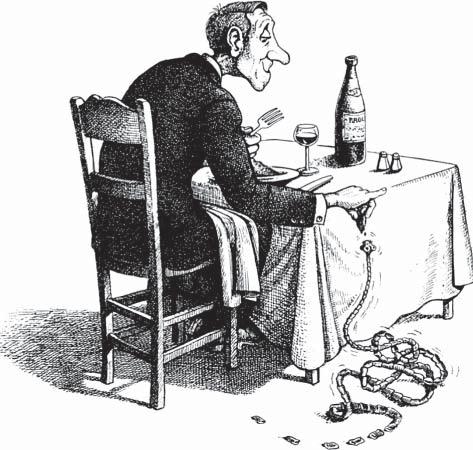
Figure1.4 Coexistenceofatypicalparasitewithitshost.Tapewormsdrawnourishment fromtheirhostandexploitthehostinthelongterm–theyare,however,onlymoderately pathogenic.(DeboucheàOreillebyClaudeSerre©EditionsGlénat2016) andresultinreducedevolutionaryfitnessofthehost,eveniftheeffectsareonly slight.Adulttapewormsmayberegardedastypicalexampleshere:theyabsorb nutrientsfromthedigestedfoodinthesmallintestineofthehost,therebyharming thehost,butdonotattackitstissues.Thehostisthusweakenedalittle,butnot killed,andtheparasitelivesoftheinterestwithouttouchingitscapital.Claude Serreexpressesallthesequalitiesveryaptlyinhiscartoon(Figure1.4).Parasites areusuallysmallerandmorenumerousthantheirhost,whereaspredatorsare largerandlessnumerousthantheirprey.Whenoneparasitesettlesonanother,we callthis hyperparasitism. Nosemamonorchis,forexample,asingle-cellorganism ofthephylumMicrospora,parasitizesthedigenean Monorchisparvus,whichis itselfaparasiteoffish.
Weusuallyexpectanintimate,physicalrelationshipbetweenparasiteand host.Intimatecontactlikethisexistsinendoparasitismand(inmanycases) ectoparasitism.Therearealsoformsofparasitisminwhichthephysicalcontact betweenthepartnersislessintimate,wheretheparasitedoesnotexistasa pathogen,butexploitsthehostinotherways.Theexploitationofinteractions betweenmembersofsocialorganismsisdefinedas socialparasitism.Inthe caseofsocialinsectssuchasants,theinteractionsofahostspeciesareexploited byaparasiticspecies.Thespectrumofsocialparasitismrangesfromfoodtheft toslaveryandthetargetedassassinationofthequeen,whichisthenreplaced bythequeenofaparasiticspecies.Onespecificformofsocialparasitismisthe exploitationofadifferentspeciestorearone’sownoffspring,whichisknown as broodparasitism.Awell-knownrepresentativeofthebroodparasitesisthe
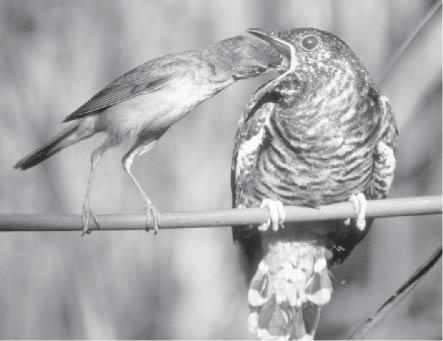
Figure1.5 Broodparasitism:Ayoungcuckooisfedbyawarbler.(Image:Courtesyof OldrichMikulica.)

Figure1.6 Phoresy:Miteslatchontoasextonbeetle,“hitchingaride”tothenearestcarrion.(DrawingfromaphotobyFrankKöhler.)
cuckoo(Cuculuscanorus).Thefemaleofthespecieslaysitseggsinthenests ofsmallersongbirdstohavethemraiseitsyoungones(Figure1.5).Thecuckoo bee’sbehaviorisverysimilar.Cuckoobeesaccountfor125ofatotalof547 speciesofbeesinGermany–afactthatsaysmuchforthesuccessofthisform ofparasitism.Notonlyfoodbutalsofunctionssuchastransportationcanbe exploitedbyparasites.Forinstance,somemitesandcertainnematodeslatchon toinsectsfortransportation.Inthistypeofparasitism, phoresy,thecarriersare referredtoastransporthosts(Figure1.6).
Parasitoidism occurswhenthedeathofthehostisalmostinevitablefollowingparasiticexploitation.Onetypicalexampleofthisinvolvesichneumonwasps, whichlaytheireggsoncaterpillars.Whentheyoungwaspshatch,theyfeedon thehost’stissues(Figure1.7).Theparasiticwasplarvaefirstdevourthebodyfat, andtheneatthemuscletissueandfinallykilltheirhostsbyconsumingtheneural
Figure1.7 Parasitoidism:Aparasiticwaspofthegenus Ichneumon laysitseggsinacaterpillar.(Fromaphotoin“TheAnimalKingdom,”courtesyofMarshallCavendishBooksLtd.)
tissue.Thelarvaefinallybreakoutofthecaterpillarandpupate.Aparasitoidlike thisattacksthecapital,ratherthanlivingoftheinterest.However,itdoesexploit thehostforarelativelylongperiodoftimeandonlykillsitwhentheparasitoidis finishedwithit.
Theinteractionbetweenparasitoidsandtheirhostshowssomesimilarities to predator–preyrelationships,forexample,betweenalionandwildebeest (Figure1.8).However,whereastheparasitoidonlykillsitshostaftereatingmost ofit,thepreyisimmediatelykilledbythepredatorandtheneaten.Inaddition, predatorsaretypicallylargerthantheirprey,andconsumemorethanonepreyin theirlifetime,twofeaturesthatseparatethemfromparasites.

Figure1.8 Predator–preyrelationship:Alionattacksawildebeest.(Image:IngoGerlach, www.tierphoto.de.)
1.1.3
DifferentFormsofParasitism
Organisms,whichcanliveasparasites,butarenotnecessarilydependenton theparasiticmodeofliferepresent facultativeparasites.Oneexampleisthe bloodsuckingkissingbug, Triatomainfestans. Itcanalsoliveasapredatorby suckingoutthehemolymphofsmallerinsects. Obligateparasites haveno alternativeotherthantheirwayoflife.Inthecaseofsomeorganisms,onlyone sexlivesparasitically.Inmosquitoes,forinstance,onlythefemalesneedamealof bloodtoproduceeggs;themalefeedsonthesapofplants. Permanentparasites areparasiticinallstagesoftheirdevelopment,while temporaryparasites spend onlycertainphasesoftheirlifeinahost.
An ectoparasite attachestotheskinorotherexternalsurfaces(e.g.,thegills)of itshost,whereitsubsistsonhairorfeathers,feedsonskin,orsucksbloodortissue fluidsubstance.Includedamongectoparasitesarenumerous temporaryparasites (sometimescalledmicropredators),whichonlyseekouttheirhoststofeed (e.g.,bloodsuckingmosquitoes),andmany permanentparasites thatremainin constantcontactwiththeirhosts(e.g.,lice,orthemonogeneansparasiticonfish). Parasitesthatliveinsidetheirhostsareknownas endoparasites.Thewormslivinginthegutlumenofvertebratesillustratethesimplestformofendoparasitism. Thedifferencebetweenrottingsubstancesintheoutsideworldandthecontentsof thedigestivetractisnotparticularlysignificantanditisrelativelycommontofind organismsthathaveadaptedtoendoparasitismofthistype.Oneexampleofthese residentsofthegutlumenisthenematode Strongyloidesstercoralis,thelifecycle ofwhichillustratesthatithastheoptionofeitherthefree-livingortheparasitic modesoflife.Otherendoparasiteseitherliveinorgans(suchasthegreatliverfluke Fasciolahepatica),livefreelyinthebloodoftheirhosts(suchas Trypanosoma brucei),orinhabitbodytissue(suchasthefilarialnematode Onchocercavolvulus). Intracellularparasites induceverypronouncedchangesinthehostcell:using thesehighlyspecificmechanisms,theseparasites(e.g., Leishmania and Plasmodium)invadehostcells,reorganizethemtofittheirownneeds,andexploitthis extremeecologicalnicheduetoamultitudeofadaptations.
Asanadaptationtotheirmodesoflife,manyparasiteshaveevolvedcomplex lifecycles,whichincludeswitchingbetweenmultiplehostsandsexualand asexualreproduction(Figure1.9).Inthesimplestformsofparasitism,only onehostisexploited;theseparasitesasreferredtoas monoxenous (Greek mónos = single, xénos = foreign).Inthiscase,transmissionfromonehosttothe nexttakesplaceamongmembersofthesamehostspecies,andisreferredto as directtransmission.Bycontrast, indirecttransmission occurswhenthe parasiteswitchesbetweentwoormorehostspecies.Theseparasitesareknown as heteroxenous (hetero = differing);theircomplexcyclesrequiretwoorthree, sometimesevenfour,hostspecies,dependingontheparasite.Byswitchinghosts fromonestageoftheirlifecycletothenext,heteroxenousparasitesachieve greateroverallfitness,ortransmissionefficiency,thantheywouldbyutilizing asinglehostpergeneration.Forexample,theuseofbloodsuckingmosquitoes
Visit https://ebookmass.com today to explore a vast collection of ebooks across various genres, available in popular formats like PDF, EPUB, and MOBI, fully compatible with all devices. Enjoy a seamless reading experience and effortlessly download highquality materials in just a few simple steps. Plus, don’t miss out on exciting offers that let you access a wealth of knowledge at the best prices!


